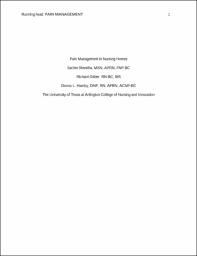
ATTENTION: The works hosted here are being migrated to a new repository that will consolidate resources, improve discoverability, and better show UTA's research impact on the global community. We will update authors as the migration progresses. Please see MavMatrix for more information.
Show simple item record
| dc.contributor.advisor | Hamby, Donna L. | |
| dc.contributor.advisor | Gilder, Richard E. | |
| dc.contributor.author | Shrestha, Sachin | |
| dc.date.accessioned | 2020-03-04T20:44:33Z | |
| dc.date.available | 2020-03-04T20:44:33Z | |
| dc.date.issued | 2020 | |
| dc.identifier.uri | http://hdl.handle.net/10106/29011 | |
| dc.description.abstract | Background: Pain is a leading cause of disability and a major contributor to health care costs.
Over 85% of patients in nursing homes report pain on a daily basis (CDC, 2016). The rescheduling
of hydrocodone to schedule II created an unprecedented challenge for physicians to write a
triplicate prescription for patients in the nursing homes who required hydrocodone to manage pain.
To circumvent the problem, one nursing home used Buprenorphine Transdermal System (BTDS)
for pain management, which is a schedule III opioid analgesic that does not require the triplicate.
Design and Method: A pre- and post- intervention design was utilized to explore the efficacy,
safety, and tolerability of the BTDS among nursing home patients who had chronic and postoperative pain. Pain scores were analyzed during the admission, 48 hours, 72 hours, week 1, week
2, and week 3. The Universal Pain Assessment Tool was used to measure the pain scores and an
Independent Samples Kruskal-Wallis test followed by a post-hoc analysis was used to determine
the significance of difference among the pain scores.
Results: The differences in the pain scores were statistically significant (alpha < 0.05) for the total
sample, chronic pain group, and post-operative pain group. The overall pain improved by 42.5% in
48 hours and 58.1% in 72 hours. The average pain scores were down to 3/10 by week 1 and 2/10
by week 2. The use of adjunct pain medications (Tramadol or Tylenol #3) also declined
progressively during the course of treatment with BTDS.
Conclusion: The chronic and post-operative pain were safely and effectively managed with BTDS;
thus, BTDS could be used as an alternative analgesic armamentarium to provide adequate pain
relief among nursing home patients who do not have access to Schedule II pain medications. | |
| dc.title | Pain Management in Nursing Homes | en_US |
| dc.type | DNP Project | en_US |
| dc.publisher.department | College of Nursing and Health Innovation, The University of Texas at Arlington | |
Files in this item
- Name:
- Shrestha_DNP Manuscript.pdf
- Size:
- 1.500Mb
- Format:
- PDF
- Description:
- PDF
- Name:
- Shrestha_DNP Poster.pdf
- Size:
- 160.4Kb
- Format:
- PDF
- Description:
- Poster
- Name:
- Shrestha_DNP PPT.pdf
- Size:
- 1.717Mb
- Format:
- PDF
- Description:
- PPT
This item appears in the following Collection(s)
Show simple item record




